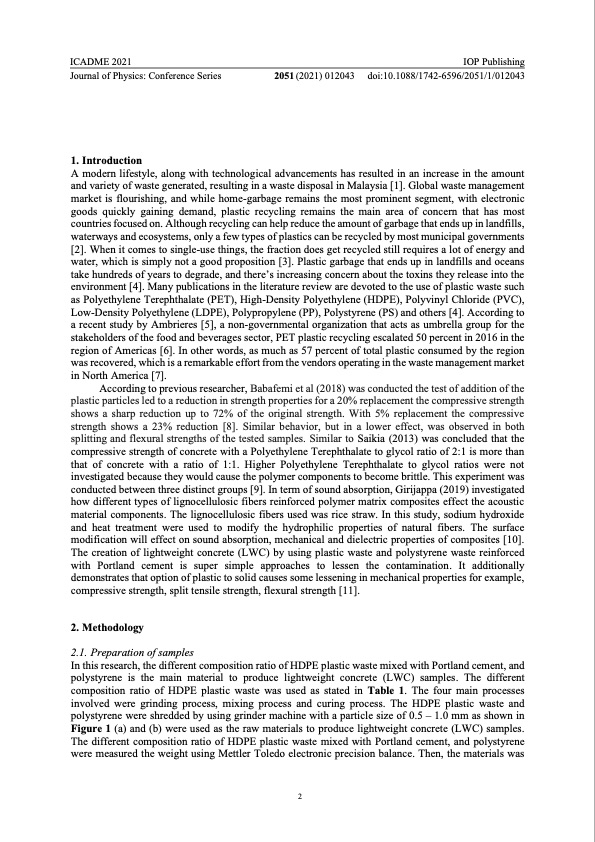
PDF Publication Title:
Text from PDF Page: 003
ICADME 2021 IOP Publishing Journal of Physics: Conference Series 2051 (2021) 012043 doi:10.1088/1742-6596/2051/1/012043 1. Introduction A modern lifestyle, along with technological advancements has resulted in an increase in the amount and variety of waste generated, resulting in a waste disposal in Malaysia [1]. Global waste management market is flourishing, and while home-garbage remains the most prominent segment, with electronic goods quickly gaining demand, plastic recycling remains the main area of concern that has most countries focused on. Although recycling can help reduce the amount of garbage that ends up in landfills, waterways and ecosystems, only a few types of plastics can be recycled by most municipal governments [2]. When it comes to single-use things, the fraction does get recycled still requires a lot of energy and water, which is simply not a good proposition [3]. Plastic garbage that ends up in landfills and oceans take hundreds of years to degrade, and there’s increasing concern about the toxins they release into the environment [4]. Many publications in the literature review are devoted to the use of plastic waste such as Polyethylene Terephthalate (PET), High-Density Polyethylene (HDPE), Polyvinyl Chloride (PVC), Low-Density Polyethylene (LDPE), Polypropylene (PP), Polystyrene (PS) and others [4]. According to a recent study by Ambrieres [5], a non-governmental organization that acts as umbrella group for the stakeholders of the food and beverages sector, PET plastic recycling escalated 50 percent in 2016 in the region of Americas [6]. In other words, as much as 57 percent of total plastic consumed by the region was recovered, which is a remarkable effort from the vendors operating in the waste management market in North America [7]. According to previous researcher, Babafemi et al (2018) was conducted the test of addition of the plastic particles led to a reduction in strength properties for a 20% replacement the compressive strength shows a sharp reduction up to 72% of the original strength. With 5% replacement the compressive strength shows a 23% reduction [8]. Similar behavior, but in a lower effect, was observed in both splitting and flexural strengths of the tested samples. Similar to Saikia (2013) was concluded that the compressive strength of concrete with a Polyethylene Terephthalate to glycol ratio of 2:1 is more than that of concrete with a ratio of 1:1. Higher Polyethylene Terephthalate to glycol ratios were not investigated because they would cause the polymer components to become brittle. This experiment was conducted between three distinct groups [9]. In term of sound absorption, Girijappa (2019) investigated how different types of lignocellulosic fibers reinforced polymer matrix composites effect the acoustic material components. The lignocellulosic fibers used was rice straw. In this study, sodium hydroxide and heat treatment were used to modify the hydrophilic properties of natural fibers. The surface modification will effect on sound absorption, mechanical and dielectric properties of composites [10]. The creation of lightweight concrete (LWC) by using plastic waste and polystyrene waste reinforced with Portland cement is super simple approaches to lessen the contamination. It additionally demonstrates that option of plastic to solid causes some lessening in mechanical properties for example, compressive strength, split tensile strength, flexural strength [11]. 2. Methodology 2.1. Preparation of samples In this research, the different composition ratio of HDPE plastic waste mixed with Portland cement, and polystyrene is the main material to produce lightweight concrete (LWC) samples. The different composition ratio of HDPE plastic waste was used as stated in Table 1. The four main processes involved were grinding process, mixing process and curing process. The HDPE plastic waste and polystyrene were shredded by using grinder machine with a particle size of 0.5 – 1.0 mm as shown in Figure 1 (a) and (b) were used as the raw materials to produce lightweight concrete (LWC) samples. The different composition ratio of HDPE plastic waste mixed with Portland cement, and polystyrene were measured the weight using Mettler Toledo electronic precision balance. Then, the materials was 2PDF Image | analysis of HDPE plastic

PDF Search Title:
analysis of HDPE plasticOriginal File Name Searched:
Manaf_2021_Phys3A_2051_012043.pdfDIY PDF Search: Google It | Yahoo | Bing
Development of a solar powered Electric Ship The Electricship website originally started off as a project to develop a comprehensive renewable, affordable, modular electric ship... More Info
Modular Boat Hull Composite The case for a unsinkable, modular composite hybrid boat hull... More Info
MS Burgenstock Hybrid Electric Catamaran Lake Lucerne Unique shuttle servicing Lucerne to the Burgenstock Resort... More Info
Ground Power Unit GPU Powered by Lithium Ion Batteries The goal of the Ground Power Unit is to provide a readily accessible, modular, ready-to-power solution for remote power... More Info
| CONTACT TEL: 608-238-6001 Email: greg@electricship.com | RSS | AMP |